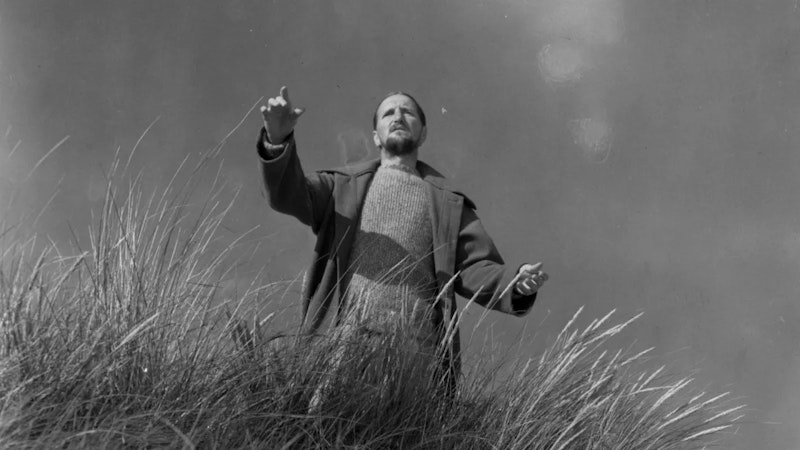The most admirable time in an artist’s life for me is when I can no longer understand them. The artist could be acting intuitively or with strained effort, but I’d have no idea because I can’t perceive the logic they’re operating on. They’re beyond convention, living in a form all their own. Beyond language, beyond description, and pulling up from the bottom of the well of feeling.
In Carl Theodor Dreyer’s penultimate film, Ordet (1955), the camera moves when it shouldn’t. Dreyer’s film, while marked by stunning compositions, could be accused of having theatrical, often artificial-seeming mise-en-scene, especially in its interior sequences. Characters will move around the frame as if they were in the space of the stage—that is, until Dreyer’s camera pans. It’s a strange movement for a film in 1955, or any time period. Sometimes accompanied with a light horizontal dolly, these pans don’t serve an emotional purpose. In fact, most of the times these pans take place, it is likely a simple cut between compositions would provide something more visceral and immediate. Instead, they create an odd distance between viewer and the characters on screen, as if we were not just an observer but some ghostly participant within the space.
Ordet concerns itself with a family in rural Denmark, the Borgens, in what must be the 20th century but feels out of time, a world of plastered walls and big wool coats and wind blowing over tall grass on the dunes. The first sequence involves the father of the house, Morten (Henrik Malberg), awaking to find out his son Johannes (Preben Lerdorff Rye) has wandered over the dunes again. Slowly, the whole house learns of the predicament, and Morten and his two other sons, Mikkel (Emil Hass Christensen) and Anders (Cay Kristiansen), shuffle over the dunes too in search of Johannes. At first, we don’t see what’s beyond the dunes—just the sharp clouds against a black sky, and people standing high on them, their bodies straddling heaven and earth.
Johannes believes himself to be Jesus Christ. He wanders around the house speaking in verse and sighting the Holy Spirit in car headlights passing through the walls. Johannes’ insanity is strangely beautiful—he’s the spiritual center of the film, consumed by madness within the confines of a religiously skeptical household. The only one who takes Johannes seriously is one who does so naively: Lillienger (Susanne Rud), the youngest child in the house and daughter to Mikkel and Inger (Birgitte Federspiel). Mikkel is practically the atheist of the household, outweighing even his father’s own ambivalence towards religion, but Inger is the most faithful of all, at least disregarding the psychosis of Johannes. But while Johannes has a practically apocalyptic religiosity, one with an off-putting intensity, Inger manifests her faith with particular kindness and quiet jouissance. There’s a simple affability to Inger’s faith in contrast to Johannes’ zealotry, yet both their approaches seem true to the poles of Christianity—the terrifying hellfire and the peaceful embrace of redemption.
Where Dreyer’s film plays is in agnosticism, a debate where nothing can be known and all can be interpreted many ways. That is, until something inexplicable happens—a miracle, a revelation of the guiding hand. The game Dreyer has been playing formally reveals itself to be polemical: even though I could still never conceive of why or how someone could imagine the way he creates a frame, let alone moves between them, every 1/24th of a second of Ordet is, not just imbued with, but constantly revealing of the director’s hand. It makes it all the clearer why Ordet transcends into the realm of the Great Movies, not just being one about its ostensible subject but about itself—not a naval-gazing for its own sake, but an epiphany about how art and religion, and our conceptions and critiques of the two, are one and the same.

